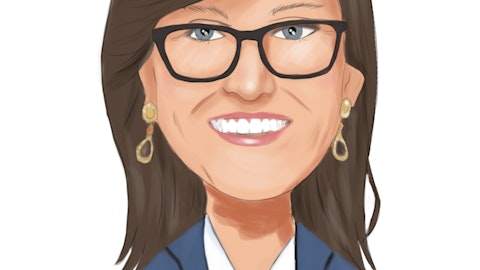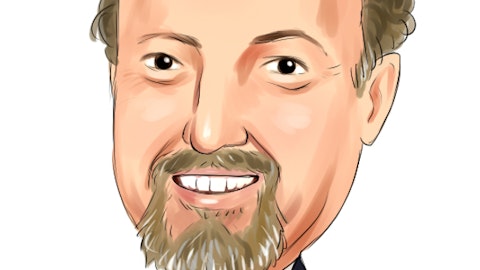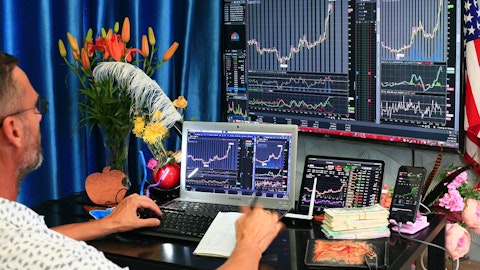So we saw the Industrial part of that start to weaken in the second half of 2023. And then late in 2023 – late in Q4 of 2023, we also started to see Automotive begin to weaken. The – our model right now has that that’s a relatively short lull in demand. And we think that that’s mainly driven by the fact that new model year introductions, every year for the automakers has a significantly higher attach rate for electronics and that’s driving a pretty good CAGR in the Automotive Semiconductor market. So we think the fundamentals are good to drive growth in Automotive. So we think that this demand lull is going to be relatively short.
C.J. Muse: Very helpful. And if I could follow-up on the SLT side. You talked about wins across both mobility and HBC. I know you have one very large customer. Would be curious the timing of the ramp of revenues here? And could they, in aggregate, get to kind of the scale of your very large customer or that will take years to do that?
Greg Smith: So the – in the prepared remarks, I was referring to system-level test wins for Mobility and for Compute. And if you put that into context, the customer that we won for Mobility is not as large as our primary SLT customer, but they have the potential to drive significant volume. In Compute, that’s something that’s going to take a while to take off. The device plans basically for SLT, it was a hyperscaler customer in Compute and the volumes for those devices is going to start at a relatively small level and then increase over time. So I don’t think that any of those in isolation would rise to the level of our historically largest customer, but it’s more additional incremental tailwinds for us.
C.J. Muse: Great. Thank you.
Operator: Our next questions are from the line of Vivek Arya with Bank of America Securities. Please proceed with your questions.
Vivek Arya: Thanks for taking my question. And I appreciate you giving the Compute TAM, which is now the largest end market. Could you help us break that between more client Compute versus data center? And then the growth rate that you’re mentioning, the 1.3% to 1.4%, that seems very modest compared to all the very high growth rates that we see in AI and data center right type products. So, if you could just give us a little more color, how much is client versus data center? And then why only such modest growth in testing? Why don’t we see more of a correlation with the growth in data-centric products?
Greg Smith: Hi, Vivek, this is Greg. So first of all, let me talk a little bit about client versus data center. As far as we can tell in 2023, most of the Test capacity adds in Compute, were really in support of data center. That the client market has been very, very quiet. Looking forward into the future, we think that the capacity adds required for cloud are going to moderate a bit. They have added a ton of productive capacity in 2023, and that is going to be felt in higher-end volumes in 2024, so they are at sort of a new high watermark in terms of that part of the market. The client side, there are two things that I think are going to accelerate things. The first is that the unit volume in PCs is at a very low point right now.
There is really nowhere to go but up. And the other is that we’ve been seeing the push in large language models in AI, primarily on the training side right now. And looking at the roadmaps for our customers, they are putting a huge push on custom silicon for Edge AI inference versus the training part. So, I think we are going to see a shift over the next 3 years, to a much more balanced market, whereas 2023 was dominated by data center, as we get out through this mid-term, it’s going to be much more balanced between data center and client. Now, in terms of the modest size, the thing that I want to just – I want to try and provide a little bit of context, that if you look back to the high watermark for the total SOC TAM, back in 2021, it was about a $4.9 billion market.
And in that $4.9 billion market, less than $1.2 billion of it was in compute. Now, fast forwarding to this year, the overall TAM is down to $3.9 billion, and compute is representing of $1.3 billion of that total. Now, as you look into 2024, that’s a very high level that it’s at right now. And that level supports significantly increased production for these devices. The last thing that I will point out is these devices are big and complex, and they have a high test intensity. But the unit volumes are relatively small, and the margin, the margin in the end market for these devices is very high. So, the revenue that compute makers are getting on these devices is pretty great. But it means that the number of testers required to fulfill that revenue demand is a little bit lower than it would be in the mobile space.
Vivek Arya: Right. And for my follow-up, I actually had two small ones. I don’t know whether they are related or not, but there was some media reports about Teradyne kind of pulling out of the China market from just the manufacturing footprint. I just wanted to see if there was any clarification around that? But the bigger question, Greg, that I have is, when I look at this mid-term model and the forecast of growing, right, kind of low, mid-20s in ‘25 and ‘26. If I look at the last decade, the only year Teradyne grew above that rate was just like one of the years, and that too was 2020. So, why keep such a high forecast and back to for 2 years, what is the kind of the visibility and confidence in hitting those kind of growth rates?
Greg Smith: Yes. So, first, just a quick comment on China. The news report is really nothing new. We have had a multiyear effort going on to increase the resilience of our supply chain. And that involved moving production locations for some of our products. We still have an extensive supply chain that is in China. We have over 600 people in China. We are competing for business and winning in China. And I think that it’s a good headline, but there is nothing new in that story or in our commitment to that region, as a place where we expect to grow. So, on the mid-term model, if you look at the – if you look with a longer lens than you are talking about, we have been in this market for 60 years. And we have seen the dynamics of the market as it comes out of downturns.





